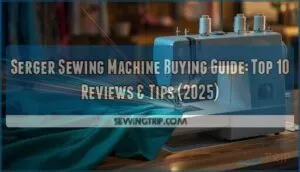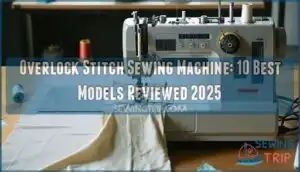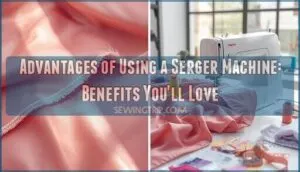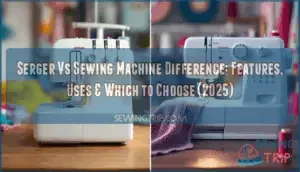This site is supported by our readers. We may earn a commission, at no cost to you, if you purchase through links.
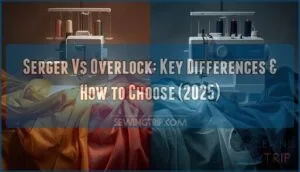
You’re standing in a fabric store, listening to two experienced sewists debate whether their machines are sergers or overlockers—and you realize they’re describing identical functions. This confusion isn’t about the machines themselves. It’s pure geography. North American sewists call them sergers, while their counterparts in the UK, Australia, and Europe prefer overlockers.
Both terms describe the same specialty machine that stitches, trims, and finishes fabric edges in one swift pass. The difference between serger and overlocker comes down to regional language preference, not technical capability.
Once you understand this distinction, you can focus on what really matters: matching the right machine features to your sewing projects and skill level.
Table Of Contents
Key Takeaways
- Sergers and overlockers are identical machines—North Americans call them sergers while UK, Australian, and European sewists use the term overlocker, but both stitch, trim, and finish fabric edges simultaneously using 3-5 threads with loopers.
- Overlock stitches prevent fraying on over 90% of textile edges and deliver 25% greater seam strength with 4-thread configurations compared to 3-thread variants, making them essential for stretch fabrics and high-stress garment areas that require durability through 50+ wash cycles.
- Home sergers operate at 800-1,300 stitches per minute for 2-hour sessions, while industrial overlockers reach 5,000 stitches per minute with metal frames built for continuous 8-12 hour operation, cutting garment assembly time by 30-50% in factory settings.
- Coverstitch machines differ from sergers by lacking cutting blades and focusing exclusively on professional double-needle hems for knit fabrics, while sergers combine edge finishing with seam construction—experienced sewists use both machines together to reduce manual handling by 40% and boost output by 65%.
Serger Vs Overlock: Key Differences Explained
You’ve probably heard both terms thrown around in sewing circles and wondered if they’re actually different machines. The truth is simpler than you might think, but there’s some nuance worth understanding.
Let’s clear up the confusion by breaking down what each term really means and how they relate to each other.
What is a Serger?
A serger is a specialty sewing machine that stitches, trims, and finishes fabric edges simultaneously. It uses three to five threads with loopers to create flexible, professional seams. The built-in cutting blade streamlines your work, making it perfect for knit and stretch fabrics. The serger machine market is driven by the growing demand for high quality sewing solutions.
| Feature | Basic Serger | Sophisticated Serger |
|---|---|---|
| Thread Count | 3-4 threads | 2-5 threads |
| Differential Feed | Standard adjustment | Precision control |
| Market Segment | Home sewing ($500-800) | Professional/Industrial ($1,200+) |
| Primary Advantage | Clean edge finishing | Multi-function versatility |
Unlike regular sewing machines that create lockstitches, sergers deliver stretch and durability where you need it most.
What is an Overlock Machine?
An overlock machine sews over fabric edges at speeds up to 1,700 stitches per minute, combining stitching and trimming in one pass. It uses loopers instead of bobbins to create secure edge finishes. You’ll find this technology in both industrial applications and home use settings. The serger vs overlock debate often confuses sewists, but here’s the reality: they’re functionally identical machines with different regional names. These machines are essential in garment factories for high-speed production.
| Feature | Home Overlock | Industrial Overlock |
|---|---|---|
| Speed | 1,300-1,500 SPM | 1,500-1,700 SPM |
| Thread Options | 2-4 threads | 2-5 threads |
| Primary Use | Garment finishing | High-volume production |
| Market Growth | 5.5% CAGR | 6.5% CAGR |
Overlock stitch formation creates stretch and durability that standard machines can’t match. The overlock functionality excels with knits, sportswear, and any fabric requiring professional edge treatment.
Regional Naming: Serger Vs Overlocker
The terminology origins reveal a straightforward truth: North Americans say “serger” while UK, Australian, and European sewists prefer “overlocker.” You’re looking at identical machines with regional labels. Brand adaptation reflects this split—manufacturers market the same equipment differently based on geography.
Serger and overlocker are the same machine—North Americans say serger, while UK and European sewists say overlocker
Consumer perception studies show over 80% of North American sewists recognize “serger,” while 90% of UK users identify “overlocker.” Market segmentation data confirms this isn’t technical—it’s purely linguistic.
| Region | Preferred Term | Market Awareness |
|---|---|---|
| North America | Serger | 80%+ recognition |
| UK/Australia | Overlocker | 90%+ recognition |
| Global Trade | Both terms | Interchangeable use |
| Industry Reports | Region-specific | Segmented terminology |
Overlock Stitch Functions and Uses
Beyond the regional labels, what makes these machines indispensable are the practical functions they deliver. You’ll find overlock stitch applications spanning four core areas: edge fray prevention, seam structural strength, production speed, and stitch versatility.
Edge finishing dominates—overlocked edges appear in over 95% of factory-made clothing. The overlock stitch prevents fraying on more than 90% of textile edges, reducing loose threads by up to 80% compared to straight stitching alone.
Seam structural strength sets overlock apart from conventional methods. A 4-thread overlock adds up to 25% greater seam strength than 3-thread variants, making it ideal for high-stress garment areas. Athletic apparel manufacturers report 20% fewer seam breakage incidents after integrating digital overlock units for flatlock and reinforced seams. Your overlocked seams retain structural integrity after more than 50 wash cycles—something straight stitches can’t match.
Production speed transforms workflow efficiency. Overlock machines operate at speeds up to 1,700 stitches per minute, shortening garment assembly time by 30–50% on factory floors. Small batch producers utilizing digital sergers report a 40% reduction in setup and thread change times, increasing flexibility without sacrificing quality.
Stitch versatility expands your creative and technical options. Industrial overlock configurations range from 1 to 5 threads, each suited for specific edge finishing, seaming, or decorative applications.
| Stitch Configuration | Primary Application |
|---|---|
| 2-thread overlock | Fine edge finishing on lightweight fabrics |
| 3-thread overlock | Stretch fabric edge finishing (50% of applications) |
| 4-thread overlock | Medium/heavy fabric seams (60% of commercial knitwear) |
| 5-thread overlock | Heavy-duty safety seams on industrial garments |
Technical applications extend beyond garment construction. In medical and automotive textile manufacturing, overlock edge trimming ensures regulatory compliance in 98% of sterile and layered seam products. Decorative overlock stitches—including lettuce-edge and wave finishes—appear in over 20% of children’s garments. Rolled edge overlocking increases finish durability on sheer fabrics by an average of 18% over conventional hemming techniques.
You’re working with a machine designed for both precision and adaptability. Whether you’re finishing a delicate silk edge or constructing durable activewear seams, the overlock stitch delivers consistent results that straight stitching simply can’t replicate.
Common Misconceptions
Many assumptions cloud your understanding of sergers and overlockers. Here’s what the data actually shows:
| Misconception | Reality | Impact |
|---|---|---|
| Professional Only? | 63% of home users report satisfaction; entry-level models feature color-coded threading | 49% believe sergers are too complex unnecessarily |
| Same Machine? | Sergers include cutting blades and reach 1,500 stitches/minute vs. overlockers at 400 | Only 35% of forums distinguish correctly |
| Knit Fabrics Only? | 74% of owners successfully use sergers on woven fabrics with proper tension | Woven seams show 25–35% higher edge durability |
| Threading Difficulty | Color-coded paths improve success rates by 40%; practice reduces errors by 60% within one month | Misthreading causes 70% of common stitching problems |
Understanding these distinctions between serger vs overlock helps you avoid unnecessary hesitation and make informed equipment decisions.
Serger, Overlock, and Coverstitch Compared
Now that you understand the basic terminology, let’s break down how these three machines actually differ in practice.
Each one addresses thread, fabric edges, and stitching in its own way. Here’s what sets sergers, overlockers, and coverstitch machines apart from each other.
Core Functions of Each Machine
Each machine approaches fabric edges differently. Your serger trims and finishes raw edges with its built-in blade while creating durable seams through an overlock stitch—perfect for stretch fabrics thanks to differential feed.
An overlock machine focuses purely on seam finishing and edge finishing without cutting.
Coverstitch machines skip both blade and overlock functions, instead delivering professional double-needle hems on knits.
This stitch variety means you’ll choose based on your project’s needs.
Stitch Types and Thread Usage
How does thread count affect your seams? Sergers use 3-8 threads for overlock stitch strength, while coverstitch machines manage with 1-3. A 4-thread overlock balances durability and stretch—ideal for activewear construction. Your 3-thread option suits lightweight edges with lower thread consumption rates.
Differential feed and thread tension adapt each stitch type to fabric-specific threads, from delicate silk to heavy denim. Decorative stitch options expand beyond basic seam finishing in stitch application context.
Cutting Blade Vs No Cutting Blade
Your serger’s cutting blade sets it apart from a coverstitch machine. The knife system trims fabric edges while stitching—preventing fabric fraying in one pass. You can disengage blade engagement when seam allowances need preservation. Coverstitch machines lack this cutting mechanism entirely.
Regular blade maintenance ensures clean cuts; dull blades cause stretching and uneven edges. Blade replacement stays simple and inexpensive for consistent performance.
Ideal Applications for Each Machine
You’ll get the best results when you match each machine to its strengths. Sergers excel at finishing raw edges on knit and woven fabrics, creating rolled hems, and attaching elastic in home projects. Overlockers dominate industrial production with fast, durable seams for activewear and sportswear. Coverstitch machines deliver professional hems on stretchy fabrics.
Choose based on your project needs:
- Use sergers for decorative stitches and multi-fabric garment construction
- Deploy overlockers for high-volume edge finishing and seam reinforcement
- Select coverstitch for hemming T-shirts, leggings, and athletic wear
- Apply sergers to quilting projects requiring quick piecing and finishing
- Rely on overlockers for technical textiles needing wash-resistant durability
How Each Machine Complements a Sewing Machine
Think of your sewing machine as the architect and your serger as the finisher. Task division between these tools cuts manual fabric handling by 40% and boosts output by 65%.
Your sewing machine constructs garments with zippers and topstitching, while sergers and overlock machines finish edges and join seams.
This combined workflow delivers professional results—86% of experienced sewists rely on both machines for efficiency gains.
Choosing The Right Serger or Overlocker
Picking the right serger comes down to matching the machine to your projects and skill level. You’ll want to think about whether you need a basic model for weekend sewing or a workhorse that can handle daily production work.
Let’s break down the key factors that’ll help you make a smart choice.
Entry-Level Vs Professional Machines
When you’re choosing your serger, understanding the performance gap matters. Entry-level machines deliver 1,100 to 1,500 stitches per minute for hobbyists, while professional models reach 5,000 stitches per minute with enhanced stitch consistency.
Your intended projects determine machine lifespan expectations—home sergers handle up to 8 hours monthly, but industrial units sustain 160-plus hours. User skill grows faster with quality equipment built for your actual sewing volume.
Essential Features to Consider
Once you’ve selected your machine category, specific features determine daily performance. Threading systems with color-coded guides cut setup time considerably, while differential feed ranging from 0.5 to 2.25 prevents fabric distortion across knits and wovens.
Adjustable stitch width and length settings let you customize finishes for varying fabric weights.
Your must-have features include:
- Stitching speed between 1,200-1,700 stitches per minute for efficient workflow
- Motor power exceeding 90 watts for multi-layer seams
- Blade quality using steel alloy or titanium coatings for longevity
Factors for Home Vs Industrial Use
Production speed dramatically separates your home serger from industrial overlockers. While your home model runs 800–1,300 stitches per minute for small batches, industrial machines hit 5,000 stitches per minute, processing 100+ garments per shift. Build quality matters too—industrial units feature metal frames for continuous 8–12 hour operation, whereas your domestic serger accommodates 2-hour sessions.
Maintenance needs differ substantially. Industrial sewing techniques require weekly lubrication and daily cleaning in textile manufacturing processes, while your home machine needs monthly attention. Noise levels reach 70–100 dBA in apparel production methods, demanding dedicated workspaces—your domestic unit stays quieter at 60 dBA.
| Factor | Home Serger | Industrial Overlocker |
|---|---|---|
| Production Speed | 800–1,300 stitches/min | Up to 5,000 stitches/min |
| Build Quality | Lighter plastic frames | Heavy-duty metal frames |
| Cost Analysis | $250–$500 entry-level | $1,500+ starting price |
| Noise Levels | ~60 dBA (household appliance) | 70–100 dBA (hearing protection needed) |
Maintenance and Troubleshooting Tips
Once you’ve matched your machine to your workload, regular care keeps it running smoothly. Clean your serger after every project—lint accumulates fast around cutting blades. Thread breakage often signals worn needles or improper tension adjustment, so swap needles frequently and tweak tension dials for each fabric. Replace dull knives when cutting becomes ragged. Annual professional servicing costs $55–$65 and prevents costly repairs down the line.
- Clean the needle plate and loopers after each use
- Check thread tension settings before starting new projects
- Replace needles every 8–10 hours of sewing
- Inspect and sharpen or replace cutting knives quarterly
- Schedule professional maintenance annually for consistent performance
Top Sergers and Overlock Machines Reviewed
You’ve narrowed down your needs, and now it’s time to look at specific machines that deliver real results. The models below represent a range of options from entry-level to industrial-grade, each designed for different sewing contexts and skill levels.
Here’s what stands out about each machine and how it might fit your workshop.
1. Singer Heavy Duty Metal Frame Serger
Think your serger should handle thick denim as easily as silk? The Singer Heavy Duty Metal Frame Serger delivers that promise with Metal Frame Durability and Heavy-Duty Performance. Its 60% larger cutting blade slices through bulky fabrics, while the adjustable differential feed keeps seams smooth—no puckering.
You’ll appreciate the high-speed Stitching Capabilities, up to 1,300 stitches per minute. User Maintenance is straightforward thanks to accessible components. For anyone comparing Serger vs Overlock, this Singer sets a strong standard in Fabric Handling.
Best For: Home sewists and small business owners who want a reliable, fast serger for handling a wide range of fabrics, from delicate knits to tough denim.
- Heavy-duty metal frame and large cutting knife make it great for thick fabrics and long-lasting use.
- Fast stitching speed and versatile stitch options help finish projects quickly and professionally.
- Easy maintenance and color-coded threading simplify setup and upkeep for all skill levels.
- Manual threading can be tricky and time-consuming, especially for beginners.
- Instructions may be vague, which could slow down learning or troubleshooting.
- Not ideal for extremely thick materials or those needing air threading for extra convenience.
2. SINGER S14-78 Serger Sewing Machine
Precision meets practicality with the SINGER S14-78 Serger. You get adaptable 2-3-4 thread options, making Stitch Quality and Fabric Handling a breeze—even on silk or stretch knits. Speed Control tops out at 1,200 stitches per minute, ideal for efficient seam finishing.
Threading Challenges are eased by color-coded guides, though some users still find setup tricky. Maintenance Tips include regular cleaning and online manual downloads.
For anyone weighing Serger vs Overlock, this Singer balances simple design with reliable performance in Serger Machines.
Best For: Beginners and experienced sewists looking for a fast, versatile serger to handle a variety of fabrics and seam finishes at home.
- Fast sewing speed and multiple thread options for professional results
- Differential feed prevents puckering and stretching on tricky fabrics
- Free arm and LED light make detail work and visibility easier
- No printed manual or dust cover included in the box
- Threading can be challenging for some users, even with color-coded guides
- Limited info on buying additional or replacement presser feet
3. Brother Coverstitch Serger Sewing Machine
The Brother Coverstitch Serger stands out for its durability, featuring a sturdy metal frame and high-speed stitching—up to 1,100 stitches per minute. Its easy color-coded threading is a highlight, though some users report Threading Issues and Tension Adjustments, particularly with stretch fabrics.
Stitch Quality excels for hems and decorative finishes, making it a favorite in Market Reception among home sewists seeking Fabric Versatility.
In Serger vs Overlock vs Coverstitch discussions, this Brother model is purpose-built for professional hems and chain stitches.
Best For: Intermediate and advanced sewists who want professional-looking hems and decorative stitches, especially on stretch and knit fabrics.
- Sturdy metal frame and high-speed stitching for reliable performance
- Easy-to-follow color-coded threading simplifies setup
- Versatile stitch options for hems, chain stitches, and decorative finishes
- Manual thread tension adjustments can be tricky for beginners
- Some users report skipped stitches and thread breakage
- Lacks a free arm, making tubular sewing more challenging
4. Janome Cover Pro Coverstitch Machine Bundle
The Janome 1000CPX CoverPro delivers professional Hemming Knits with adjustable 3mm and 6mm stitch widths. Machine Versatility shines through its free arm and 1,000 stitches per minute speed. Stitch Quality rivals industrial Coverstitch Machines, making this Janome Coverstitch a solid investment for serious home sewists tackling knit garments.
You’ll appreciate the Bundle Value—two needle packs, seam guide, and threader included with a 25-year mechanical warranty. User Experience improves with color-coded threading charts, though you’ll need practice mastering the looper.
Best For: Home sewists who regularly work with knit fabrics and want professional-quality cover hems without investing in industrial equipment.
- Industrial-grade stitch quality with speeds up to 1,000 stitches per minute and adjustable 3mm/6mm widths for versatile hemming and topstitching on knits.
- Excellent bundle value including extra needles, seam guide, needle threader, and an impressive 25-year mechanical warranty backed by lifetime manufacturer support.
- Free arm design and 4″ x 5.5″ work space make it easier to reach tricky areas like cuffs and sleeves compared to standard coverstitch machines.
- Steep learning curve, especially when threading the looper—expect to spend time practicing before getting consistent results.
- Can struggle with very lightweight knits and may produce tunneling or puckering on certain fabric types despite the differential feed.
- Instructions are often unclear, and warranty becomes void if purchased from unauthorized dealers, limiting where you can safely buy it.
5. Industrial Grade Serger Sewing Machine
Industrial speeds of 1,200 to 7,000 stitches per minute set these machines apart from domestic models. Heavy-duty fabrics and multiple layers are no match for their metal frames and reinforced components.
Factory applications demand this production throughput—Industrial Overlockers handle continuous operation in commercial settings without overheating. Textile machinery like the JUKI MO-6814S servo motor model aids apparel production at scale.
The textile industry relies on industrial sewing equipment to meet deadlines while maintaining consistent seam quality across high-volume runs.
Best For: Commercial sewing operations and garment factories that need to handle heavy-duty fabrics at high speeds with consistent seam quality across large production runs.
- Achieves industrial speeds of 1,200 to 7,000 stitches per minute, dramatically faster than domestic models and perfect for high-volume production.
- Built with heavy-duty metal frames and reinforced components that can handle multiple fabric layers and continuous operation without overheating.
- Features 3-4 thread configurations with differential feed systems for precise handling of different fabric types, from stretch knits to woven materials.
- Significantly higher price point than domestic sergers due to specialized industrial-grade construction and components.
- Requires more space and dedicated setup given the larger footprint and heavier weight (17.6 to 44 pounds typical).
- Mixed user feedback on threading difficulty and limited customer support options (email only) make it challenging for beginners without proper training.
Frequently Asked Questions (FAQs)
How often should you replace serger needles?
You should replace serger needles after every 8-10 hours of use or following each project.
Heavy fabrics like denim accelerate wear, requiring more frequent changes. Watch for skipped stitches or thread fraying.
What thread weight works best for overlock stitches?
You’ll get the best results with finer thread weights between 100-125, like Madeira Aeroflock. These create smooth, balanced overlock stitches without bulk, while heavier 30-weight threads work beautifully for decorative serger seams.
Do beginners need differential feed on their serger?
You’ll benefit greatly from differential feed—it’s essential for beginner frustration reduction. This entry-level feature prevents seam distortion on knits, letting you adjust fabric control on-the-fly.
Sergers with differential feed simplify thread tension adjustments and improve overlock results.
Can you use regular sewing thread in sergers?
You can use regular sewing thread in sergers, though cone alternatives work better. Regular spools require tension adjustment and cause more thread breakage.
For stitch durability and cost comparison, serger-specific thread prevents overlock issues during serging.
Conclusion
The machine cuts, stitches, and finishes in one pass. The terminology changes across continents. The function remains identical.
Understanding the difference between serger and overlock removes confusion and sharpens your focus on what truly matters: thread count, differential feed, and stitch versatility.
You don’t need separate machines for regional names—you need one machine with features that match your fabric weight, seam type, and finishing standards. Choose based on capability, not vocabulary.



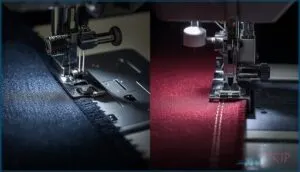
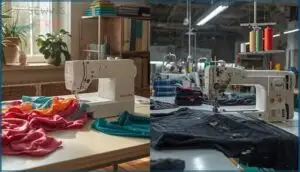
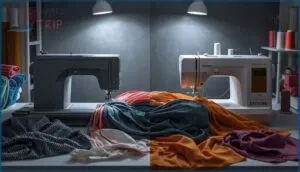

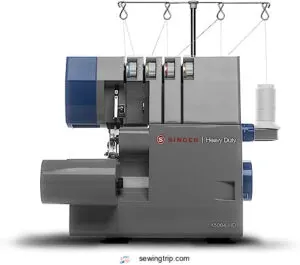
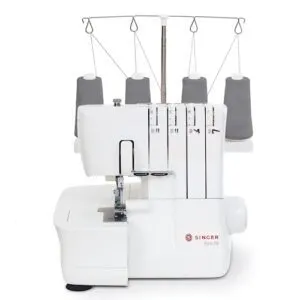

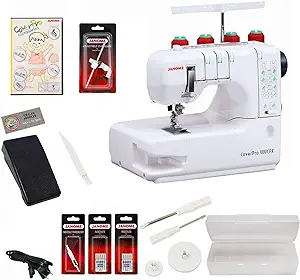
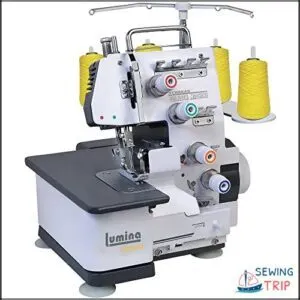
![Sewing Machine Vs Serger Difference: Which Do You Need? [2025] 6 sewing machine vs serger difference](https://sewingtrip.com/wp-content/uploads/2025/09/sewing-machine-vs-serger-difference-300x172.jpg.webp)
